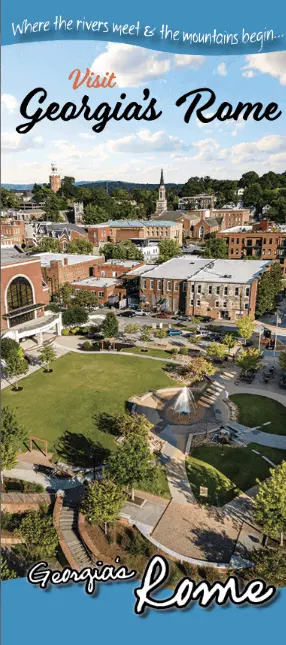Exploring Our Community
Nestled in the foothills of the Appalachian Mountains in northwest Georgia, Rome is a vibrant community that offers a unique blend of Southern charm and modern amenities. With a Metropolitan Statistical Area (MSA) population of approximately 100,000, this historic city is known for its scenic beauty, three rivers converging downtown, and rolling hills that make for picturesque views both from the ground and when flying overhead. From the air, you’d be greeted by a lush, green landscape dotted with winding waterways and tree-covered hills, offering a sense of peace and natural beauty. The Etowah, Oostanaula, and Coosa Rivers meet right in the heart of Rome, which is also marked by small mountains like Myrtle Hill and Lavender Mountain, adding to the topographical interest.
Located in the heart of the Southeast, Rome is approximately halfway between Atlanta, GA, and Chattanooga, TN, making it both conveniently accessible and pleasantly removed from the hustle and bustle of larger cities. The city is a cultural hub in the region, known for its excellent healthcare facilities, strong educational institutions, and rich history. Rome was recently recognized by U.S. News & World Report as one of the best places to live in Georgia, reflecting its high quality of life and growing reputation.
Rome’s location in the foothills of the Appalachians also places it within a short drive of some of the Southeast’s most treasured natural landmarks. Just a little over an hour’s drive will take you to the scenic wonders of the Chattahoochee National Forest or the vibrant urban life of Atlanta. Additionally, the city is a gateway to outdoor adventure with easy access to hiking, fishing, and other recreational activities in nearby national parks and state reserves. The climate in Rome is a major draw for those who appreciate the changing seasons. With mild winters, warm summers, and a long spring and fall season, residents enjoy an average of over 210 sunny days a year.
Rome is home to several notable businesses and attractions that draw people from around the region. The city’s downtown district is thriving with locally owned boutiques, restaurants, and art galleries that capture the essence of Southern hospitality. Businesses like Pirelli Tire North America have a significant presence in Rome, adding to its economic stability and attractiveness. Medical professionals are particularly drawn to the city for its state-of-the-art healthcare facilities like Redmond Regional Medical Center and Floyd Medical Center, which serve as the backbone of regional healthcare.
For those seeking more metropolitan experiences, Rome is located approximately 70 miles from Hartsfield-Jackson Atlanta International Airport, the world’s busiest airport, which offers over 200 non-stop direct flights to destinations worldwide. The city’s strategic location and easy access to both mountains and major urban centers make it an ideal spot for professionals looking for a balanced lifestyle.
Physicians who relocate to Rome are often struck by the city’s tight-knit community, affordable cost of living, and a strong sense of place. Whether it’s the charm of a historic downtown, the proximity to outdoor adventure, or the opportunity to work in a regionally respected healthcare system, Rome offers a compelling mix of professional and personal benefits. The combination of natural beauty, a favorable climate, and a supportive, growing community make Rome, Georgia, a truly inviting place to call home.
